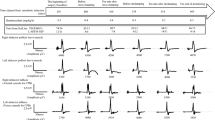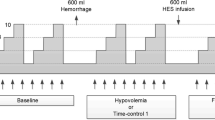Abstract
Background
Paraplegia is a serious complication of descending and thoracoabdominal aortic aneurysms (dTAAs and TAAAs) surgery. Motor evoked potentials (MEPs) enable monitoring the functional integrity of motor pathways during dTAA and TAAA surgery. Although MEPs are sensitive to temperature changes, there are few human data on changes of MEPs during mild and deep hypothermia. Therefore, we investigated changes of MEPs in deep hypothermic circulatory arrest (DHCA) in dTAA and TAAA surgery.
Methods
Fifteen consecutive patients undergoing dTAA and TAAA surgery using DHCA were enrolled. MEPs were elicited and recorded during each degree Celsius change in nasopharyngeal temperature during both the cooling and rewarming phases. Hand and leg skin temperature were also recorded simultaneously.
Results
In the cooling phase MEP amplitude decreased lineally in both the hand and leg. The MEP disappeared at ~16°C in both the hand and leg in 10 of 15 patients, but was still elicited in 5 patients. In the rewarming phase MEP in the hand recovered before the temperature reached 20°C for eight patients and 25°C for the other seven patients. In contrast, MEP in the leg recovered below 20°C for two patients and 30°C for three patients. For the other eight patients MEP waves did not recover during the rewarming phase.
Conclusion
In the cooling phase of DHCA, MEP disappeared at ~16°C in some patients but was still elicited in others. MEP recovered below 25°C in the hand. Recovery of MEP in the leg was, however, extremely variable.



Similar content being viewed by others
References
Coselli JS, Conklin LD, LeMaire SA. Thoracoabdominal aortic aneurysm repair: review and update of current strategies. Ann Thorac Surg. 2002;74:S1881–4.
Cambria RP, Clouse WD, Davison JK, Dunn PF, Corey M, Dorer D. Thoracoabdominal aneurysm repair: results with 337 operations performed over a 15-year interval. Ann Surg. 2002;236:471–9.
Coselli JS, Lemaire SA, Koksoy C, Schmittling ZC, Curling PE. Cerebrospinal fluid drainage reduces paraplegia after thoracoabdominal aortic aneurysm repair: results of a randomized clinical trial. J Vasc Surg. 2002;35:631–9.
Kouchoukos NT, Rokkas CK. Hypothermic cardiopulmonary bypass for spinal cord protection: rationale and clinical results. Ann Thorac Surg. 1999;67:1940–2.
Safi HJ, Miller CC 3rd, Carr C, Iliopoulos DC, Dorsay DA, Baldwin JC. Importance of intercostal artery reattachment during thoracoabdominal aortic aneurysm repair. J Vasc Surg. 1998;27:58–66.
Nijenhuis RJ, Jacobs MJ, Schurink GW, Kessels AG, van Engelshoven JM, Backes WH. Magnetic resonance angiography and neuromonitoring to assess spinal cord blood supply in thoracic and thoracoabdominal aortic aneurysm surgery. J Vasc Surg. 2007;45:71–7.
Kawanishi Y, Munakata H, Matsumori M, Tanaka H, Yamashita T, Nakagiri K, et al. Usefulness of transcranial motor evoked potentials during thoracoabdominal aortic surgery. Ann Thorac Surg. 2007;83:456–61.
Koja K, Kuniyoshi Y, Miyagi K, Uezu T, Arakaki K, Yamashiro S, et al. Spinal cord protection during thoracoabdominal aortic aneurysm repair; efficacy of distal aortic perfusion and segmental aortic clamping. Kyobu Geka. 2004;57:268–73.
Sueda T, Morita S, Okada K, Orihashi K, Shikata H, Matsuura Y. Selective intercostal arterial perfusion during thoracoabdominal aortic aneurysm surgery. Ann Thorac Surg. 2000;70:44–7.
Sakamoto T, Kawaguchi M, Kakimoto M, Inoue S, Takahashi M, Furuya H. The effect of hypothermia on myogenic motor-evoked potentials to electrical stimulation with a single pulse and a train of pulses under propofol/ketamine/fentanyl anesthesia in rabbits. Anesth Analg. 2003;96:1692–7.
Kawaguchi M, Furuya H. Intraoperative spinal cord monitoring of motor function with myogenic motor evoked potentials: a consideration in anesthesia. J Anesth. 2004;18:18–28.
Lotto ML, Banoub M, Schubert A. Effects of anesthetic agents and physiologic changes on intraoperative motor evoked potentials. J Neurosurg Anesthesiol. 2004;16:32–42.
Yamamoto Y, Kawaguchi M, Hayashi H, Horiuchi T, Inoue S, Nakase H, et al. The effects of the neuromuscular blockade levels on amplitudes of posttetanic motor-evoked potentials and movement in response to transcranial stimulation in patients receiving propofol and fentanyl anesthesia. Anesth Analg. 2008;106:930–4.
Browning JL, Heizer ML, Baskin DS. Variations in corticomotor and somatosensory evoked potentials: effects of temperature, halothane anesthesia, and arterial partial pressure of CO2. Anesth Analg. 1992;74:643–8.
Oro J, Haghighi SS. Effects of altering core body temperature on somatosensory and motor evoked potentials in rats. Spine. 1992;17:498–503.
Meylaerts SA, De Haan P, Kalkman CJ, Lips J, De Mol BA, Jacobs MJ. The influence of regional spinal cord hypothermia on transcranial myogenic motor-evoked potential monitoring and the efficacy of spinal cord ischemia detection. J Thorac Cardiovasc Surg. 1999;118:1038–45.
Meylaerts SA, Jacobs MJ, van Iterson V, De Haan P, Kalkman CJ. Comparison of transcranial motor evoked potentials and somatosensory evoked potentials during thoracoabdominal aortic aneurysm repair. Ann Surg. 1999;230:742–9.
Heier T, Caldwell JE, Sessler DI, Miller RD. The effect of local surface and central cooling on adductor pollicis twitch tension during nitrous oxide/isoflurane and nitrous oxide/fentanyl anesthesia in humans. Anesthesiology. 1990;72:807–11.
Kakinohana M, Nakamura S, Fuchigami T, Miyata Y, Sugahara K. Influence of the descending thoracic aortic cross clamping on bispectral index value and plasma propofol concentration in humans. Anesthesiology. 2006;104:939–43.
Author information
Authors and Affiliations
Corresponding author
About this article
Cite this article
Shinzawa, M., Yoshitani, K., Minatoya, K. et al. Changes of motor evoked potentials during descending thoracic and thoracoabdominal aortic surgery with deep hypothermic circulatory arrest. J Anesth 26, 160–167 (2012). https://doi.org/10.1007/s00540-011-1313-2
Received:
Accepted:
Published:
Issue Date:
DOI: https://doi.org/10.1007/s00540-011-1313-2




